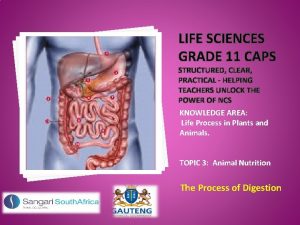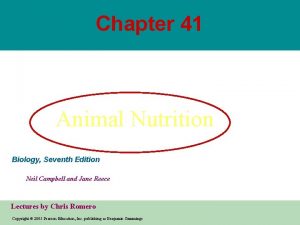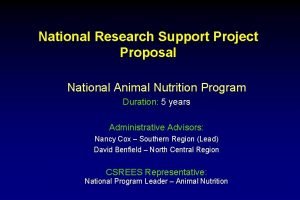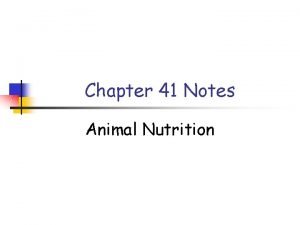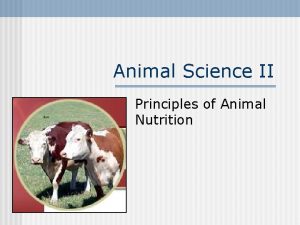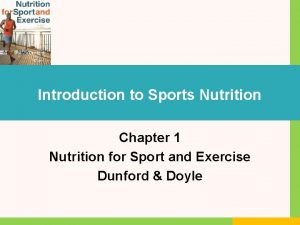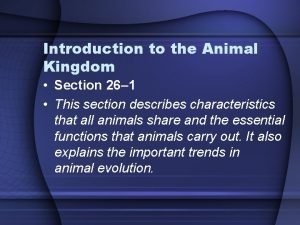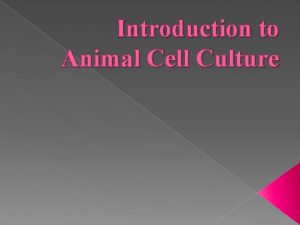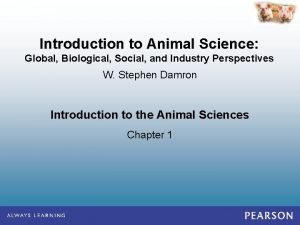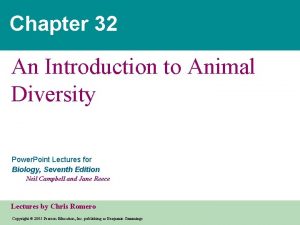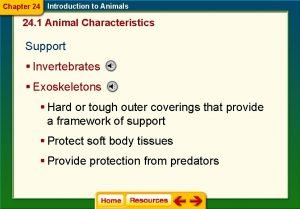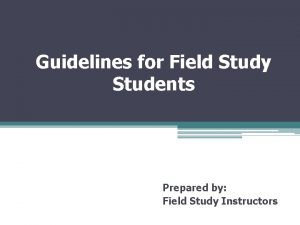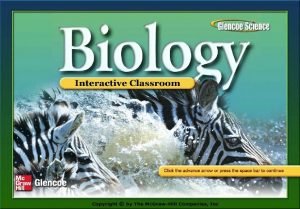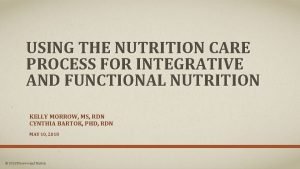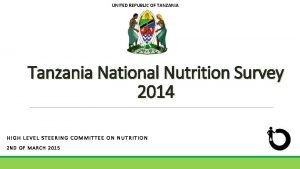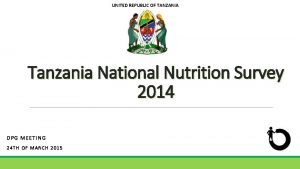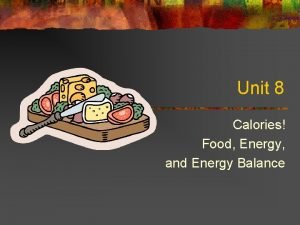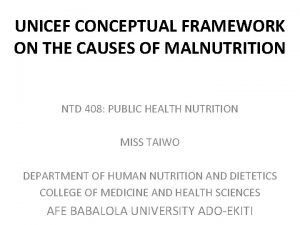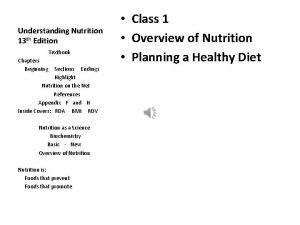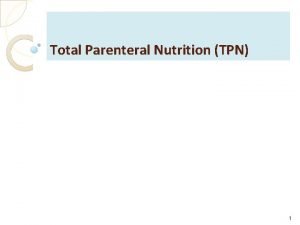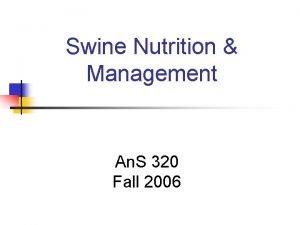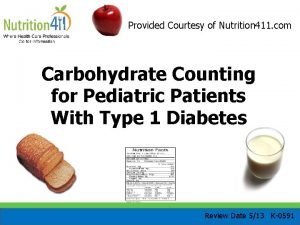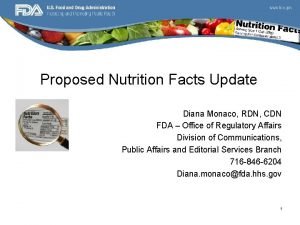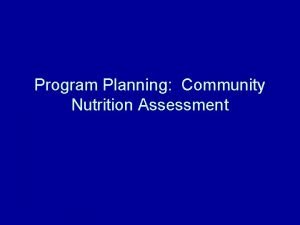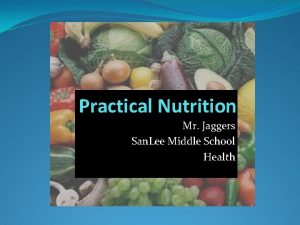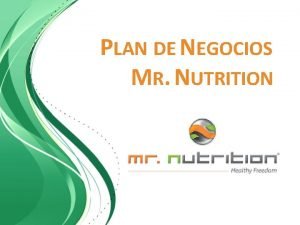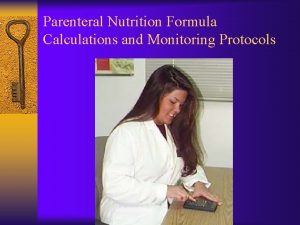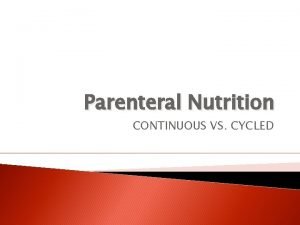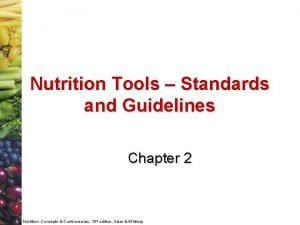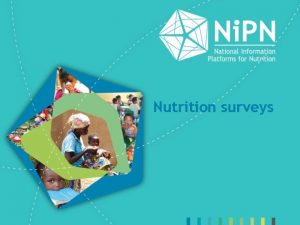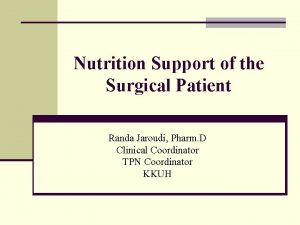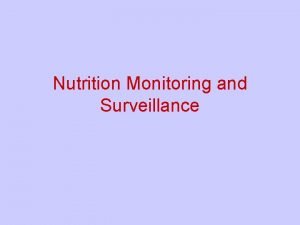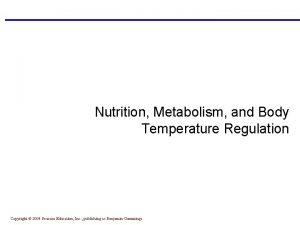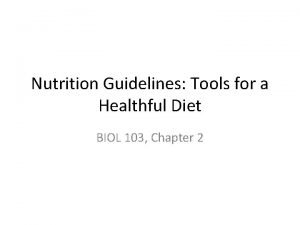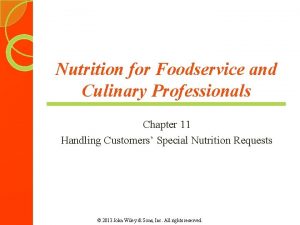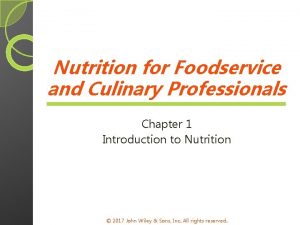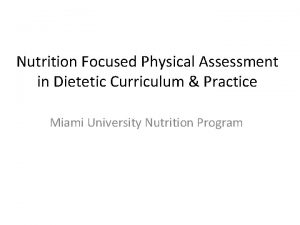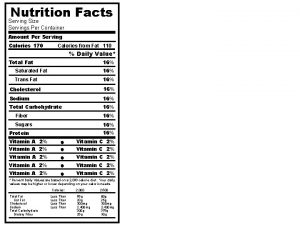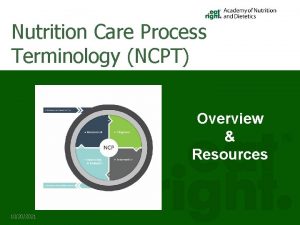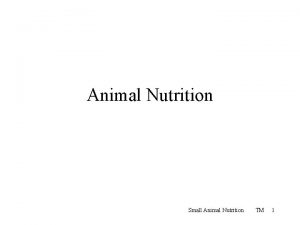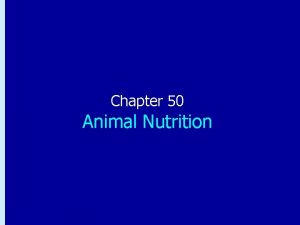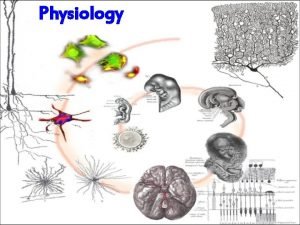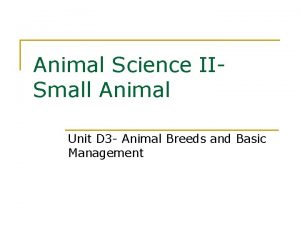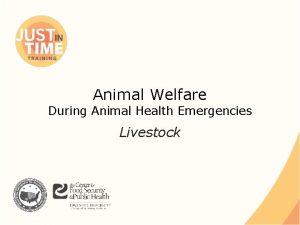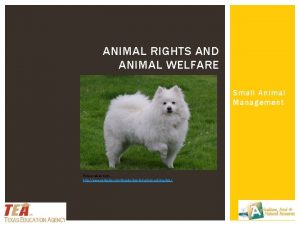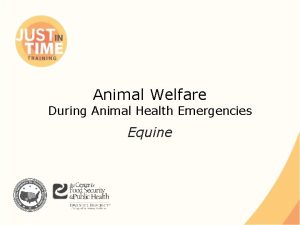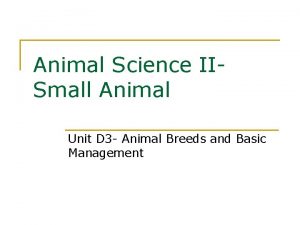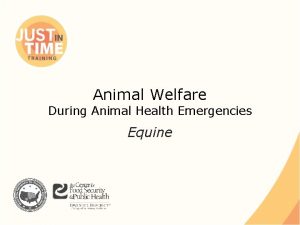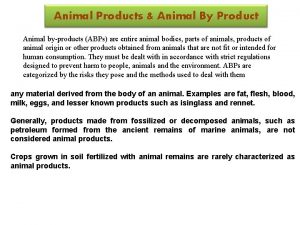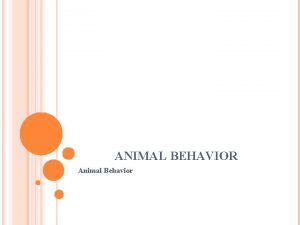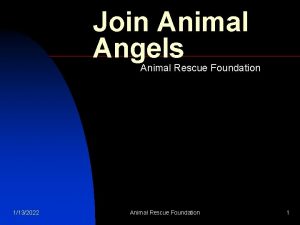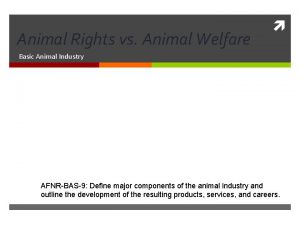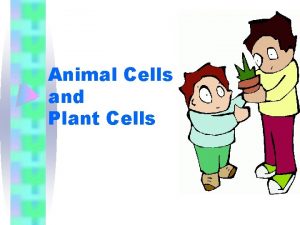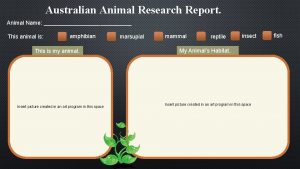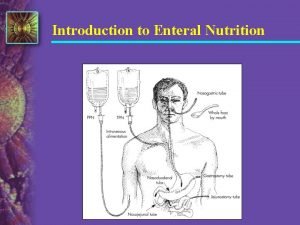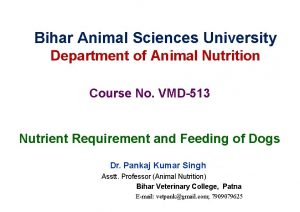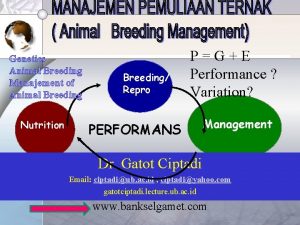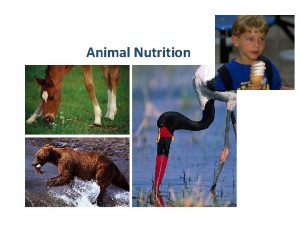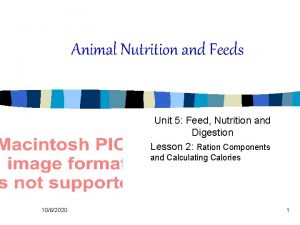ANIMAL NUTRITION INTRODUCTION STUDY OF NUTRITION 1 Study





























































- Slides: 61

ANIMAL NUTRITION INTRODUCTION

STUDY OF NUTRITION 1) Study of the six basic nutrients. 2) Study of the feedstuffs available. 3) Determination of the nutrient requirements of a given animal or group of animals. 4) Create a economical ration to meet the nutrient requirements for a given animal or group of animals.

#1 THE SIX BASIC NUTRIENTS

NUTRIENTS • Chemical element or compound that aids in the support of life. • Becomes part of the cells of the body • Necessary for cells to live, grow and function properly.

SIX BASIC NUTRIENTS 1) 2) 3) 4) 5) 6) WATER CARBOHYDRATES PROTIENS FATS or LIPIDS VITAMINS MINERALS FOUND IN ALL LIVING THINGS, REQUIRED BY ALL LIVING THINGS,

WATER

WATER • Cheapest and most abundant nutrient • Most vital component of a ration! • A lack of water has an immediate and drastic effect on the animals physiology, more so than any other nutrient.

WATER-Functions • Transports food through the digestive tract • Assists in the absorption of nutrients in the digestive system • Dissolves the nutrients the animal eats so that they can be absorbed

WATER-Functions • Necessary for the chemical reactions that occur during digestion. • Maintains the shape of the cells of the body • Lubricates and cushions joints and organs in the body cavity.

WATER SOURCES 1) Drinking Water SWINE 2½ to 5 gallons SHEEP 1 to 4 gallons BEEF CATTLE 8 to 10 gallons DAIRY CATTLE 10 to 16 gallons HORSES 10 to 14 gallons

WATER SOURCES 2) Water contained in or on feed • • • Grains range fro 8 -30% water Hays are typically 5 -6% water Fresh Grass is typically 85 -90% water • Precipitation or dew on fresh grass also contributes.

WATER SOURCES 1) Metabolic Water • • It is ‘made’ by the body as a byproduct of metabolic reactions. Accounts for 5 -10% of the total water intake C 6 H 12 O 6 + 6 O 2 6 CO 2 + 6 H 2 O

WATER LOSS 1) 2) 3) 4) Urine Feces Vaporization from lungs Sweat

WATER INTAKE • INCREASED BY: – Exposure to high temperature and humidity – High Fiber feedstuffs – High protein feedstuffs – Lactation – The volume of feed intake – Good water quality – Salt intake

WATER INTAKE • DECREASED BY: – Poor water quality – Lower environmental temperatures – Excessively cold water

WATER DEFICIENCY MILD Dehydration • Loss of skin elasticity • Loss of weight • Drying of mucous membranes and eyes • Sunken, dull eyes

WATER DEFICIENCY Moderate dehydration • Sudden reduction in milk production • Lethargy, weakness Severe dehydration – Change in body chemistry – Death

ENERGY NUTRIENTS CARBOHYDRATES FATS & OILS

ENERGY NUTRIENTS • The most important item in an animals diet. • Basic metabolism requires a certain amount of energy to proceed. • Additional amounts of energy are required for the animal to grow and produce.

ENERGY NUTRIENTS • CARBOHYDRATES – Sugars – Starches • FATS & OILS (LIPIDS) – Fatty Acids • Linolenic • Linoleic

CARBOHYDRATES • Approximately 75% of the dry weight of a plant is Carbohydrates – Largest part of the animal’s food supply • Organic nutrient, contain chains of CARBON, HYDROGEN, OXYGEN (CHO)

CARBOHYDRATES • Made by the plant, not the animal! C 6 H 12 O 6 + 6 O 2 6 CO 2 + 6 H 2 O

CARBOHYDRATES • SIMPLE – Sugars – Starches • COMPLEX – Cellulose – Hemicellulose GLUCOSE

SIMPLE CARBOHYDRATES • Easily digested • Quickly absorbed in the digestive tract (small intestine) • Easily, quickly converted to energy • Grains are typically high in simple carbohydrates (sugars and starches)

SIMPLE CARBOHYDRATES • SUGARS – GLUCOSE – FRUCTOSE – SUCROSE – GALACTOSE – MALTOSE

SIMPLE CARBOHYDRATES • STARCH – Polysaccharide • Consists of a large chain of 80 to 100 glucose molecules – Most important non-fiborus carbohydrate found in plants. GLUCOSE

COMPLEX CARBOHYDRATES; Fiber • CELLULOSE • HEMICELLULOSE GLUCOSE

COMPLEX CARBOHYDRATES; Fiber • CELLULOSE – 25 -30% of the fiber in plants is cellulose – Found in roots, stems – Most abundant carbohydrate in a plant

COMPLEX CARBOHYDRATES • CELLULOSE – Animals do not have the enzymes or ability on their own break these chains of cellulose into glucose! • However, ruminant animals have bacteria in their digestive system that can destroy the chains and release the glucose molecules.

FATS AND OILS • Fats and Oils (or Lipids) are insoluble organic compounds. – Organic = means they are made of carbon chains – Insoluble = means they will not dissolve in water. • Highly digestible source of energy

LIPIDS • Serve as a concentrated source of energy. 1 kg of Carbohydrate = 4. 2 mcals of energy 1 kg of Lipid = 9. 45 mcals of energy 9. 45 mcals/4. 2 mcals= 2. 25 times more energy In a kg of Lipid, than a kg of Carbohydrate

LIPIDS • Important to: – Source of dietary energy – Provide heat, insulation and protection for the body – Source of essential fatty acids which are important to: • Cell structure • Absorption of Vitamins • Biochemical functions in the body

LIPIDS • Made up of one or more FATTY ACIDS plus a GLYCEROL molecule.

SATURATED FATTY ACIDS • EACH CARBON HAS THE MOST HYDROGENS THEY CAN HAVE H H C H C O H

UNSATURATED FATTY ACIDS • CARBONS ARE JOINED BY A DOUBLE BOND, SO WHICH TAKES THE PLACE OF A HYDROGEN H C H C O H

LIPIDS • OILS – Liquid at room temperature – Are typically made of saturated fatty acids • FATS – Solid at room temperature – Typically made of unsaturated fatty acids.

FATTY ACIDS • ESSENTIAL FATTY ACIDS – Are those fatty acids that cannot be synthesized by the animal – Must be included in the diet of the animal • LINOLEIC ACID • LINLENIC ACID IMPORTANT PART OF CELL MEMBRANES

DEFICIENCIES OF FATTY ACIDS • • • Poor growth Poor Hair coat Scaly, flaky skin Poor feather development Loss of production Poor reproductive performance

PROTEIN The building blocks!

PROTEIN • Essential to the tissues of all biological organisms • Found in higher concentrations in organs and muscle tissue than any other constiuent… except water! • Range from highly soluable to highly insoluable – Feathers, hooves and hair – Plasma proteins in the blood.

PROTEIN • Each protein has a distinctive function in the body. – Structural proteins: Hair, Skin, Muscles – Metabolic proteins: Enzymes, Hormones, immune antibodies • DNA controls the synthesis of all proteins, regardless of the function.

AMINO ACIDS • Over 200 naturally occurring amino acids • Yet 20 amino acids make up about 99% of all plant and animal proteins • Plants are capable of synthesizing all the amino acids – Inorganic Nitrogen sources provide the necessary nitrogen! • AMMONIA, NITRATE, ORGANIC FERTILIZERS

PROTEIN Amino Acids; building blocks of proteins Threonine Tryptophan Lysine Threonine

ESSENTIAL AMINO ACIDS • • • Arginine Histidine Isoleusince Leucine Lysine • • • Methionine Phenylalanine Threonine Tryptophan Valine

MOST LIKELY TO BE DEFICIENT • LYSINE • METHIONINE • TRYPTOPHAN

PROTEIN FUNCTIONS • Basic Structural unit – Collagen – Elastin – Blood proteins – Contractile proteins (muscle) – Blood proteins

PROTEIN FUNCTIONS • Body Metabolism – Enzymes • Digestion – Hormones – Immune Antibodies – DNA translation

DEFICIENCIES OF PROTEIN • • • Reduced growth rate Reduced feed efficiency Anemia Infertility Reduced birth weights Reduced milk production

MINERALS INORGANIC NUTRIENTS

MINERALS • Inorganic, solid, crystalline • Total mineral content of an animals diet is called ASH • 3 -5% of the animals ‘dry-weight’ is ASH – ½ of the total ASH is Calcium – ¼ of the total ASH is Phosphorus – ¼ of the remaining ASH is made of the remaining minerals.

MACROMINERALS (MAJOR) • Minerals that are present in ASH at greater than 100 ppm • Needed in larger quantities than the minor (trace) minerals – CALCIUM (Ca+) – SODIUM (Na+) – POTASSIUM (K+) – SULFUR (Na+) -PHOSPHORUS (P) -CHLORIDE (Cl-) -MAGNESIUM (Mg+)

General Functions • • Skeletal formation Protein Synthesis Oxygen transport Fluid balance Acid/Base balance Enzymes Muscle contractions

TRACE MINERALS (MINOR) • Minerals that make up less than 100 ppm of the body’s ASH • Needed in smaller quantites than the macrominerals. – COLBALT (Co) – FLUORINE (F) – IRON (Fe) – MOLYBDENUM (Mo) – ZINC (Z) -COPPER (Cu) -IODINE (I) -MANGANESE (Mg) -SELENIUM (S)

TRACE MINERAL FUNCTIONS • • • Hair, Skin, Wool and Feathers Bone Growth Reproduction Muscle contractions Oxygen Transport Digestive enzymes

VITAMINS

VITAMINS • Essential – Development of tissue – Metabolic reactions • Do not enter the structural portion of the body! • Deficiencies result in specific disease • Cannot be synthesized by animals… must be ingested or synthesized by the microbes in the rumen.

FAT SOLUABLE • Dissolves only in fat! • Can only be absorbed in the presence of fat. • Contain only carbon, hydrogen and oxygen • Occur in plant tissues in the ‘provitamin’ form only. • Required for the regulations of metabolism

FAT SOLUABLE • • Vitamin A Vitamin D Vitamin E Vitamin K

WATER SOLUABLE • Dissolve easily in water • Contain Carbon, Hydrogen, Oxygen and either a Nitrogen, sulfur or cobalt • No provitamins are known • Responsible for the transfer of energy • Absorbed easily into the bloodstream

GENERAL FUNCTIONS • Necessary for both growth and maintenance of life • Promote general health and vigor • Promote antibody synthesis, increases immune response

STABLITY • Water soluble vitamins are more tolerant than fat soluble. – B vitamins are more stable than vitamin A, D, C, and K – Vitamin A is the least stable of the fat soluble vitamins.
 Life science grade 11 animal nutrition
Life science grade 11 animal nutrition Unit 26 animal anatomy physiology and nutrition
Unit 26 animal anatomy physiology and nutrition Animal nutrition grade 11 practical
Animal nutrition grade 11 practical Animal nutrition 7th edition
Animal nutrition 7th edition Unit 26 animal anatomy physiology and nutrition
Unit 26 animal anatomy physiology and nutrition National animal nutrition program
National animal nutrition program Animal nutrition notes
Animal nutrition notes Principles of animal nutrition
Principles of animal nutrition Animal vs plant cell venn diagram
Animal vs plant cell venn diagram Venn diagram animal and plant cells
Venn diagram animal and plant cells Similarities between animal rights and animal welfare
Similarities between animal rights and animal welfare Definition of sports nutrition
Definition of sports nutrition Introduction to public health nutrition
Introduction to public health nutrition Cyq qualifications
Cyq qualifications Section 26-1 introduction to the animal kingdom
Section 26-1 introduction to the animal kingdom Introduction of animal cell
Introduction of animal cell Importance of animal science
Importance of animal science Introduction to animal diversity
Introduction to animal diversity Chapter 24 section 1 animal characteristics
Chapter 24 section 1 animal characteristics Intro paragraph outline
Intro paragraph outline Introduction to field study 1 in education
Introduction to field study 1 in education Chapter 1 the study of life
Chapter 1 the study of life Study tour introduction
Study tour introduction What is case series
What is case series Retrospective cohort study vs prospective cohort study
Retrospective cohort study vs prospective cohort study Work study technique
Work study technique Marty lobdel
Marty lobdel Phytogeographical regions of world
Phytogeographical regions of world Objective of work study
Objective of work study Difference between time study and motion study
Difference between time study and motion study Gcse food tech high skill dishes
Gcse food tech high skill dishes Nutrition care process
Nutrition care process Tanzania national nutrition survey 2019
Tanzania national nutrition survey 2019 Tanzania national nutrition survey 2018
Tanzania national nutrition survey 2018 Biobeyond unit 8 nutrition lab counting calories
Biobeyond unit 8 nutrition lab counting calories Unicef conceptual framework of malnutrition
Unicef conceptual framework of malnutrition Understanding nutrition 13th edition rental
Understanding nutrition 13th edition rental Tpn injection
Tpn injection Swine nutrition management
Swine nutrition management Specialized nutrition support
Specialized nutrition support Nutrition 411
Nutrition 411 Monaco drink nutrition facts
Monaco drink nutrition facts Nutrition program planning
Nutrition program planning Prime astaxanthin
Prime astaxanthin Jaggers nutrition menu
Jaggers nutrition menu Mr nutrition el palo
Mr nutrition el palo How to calculate calories in dextrose solutions
How to calculate calories in dextrose solutions Tpn cycling
Tpn cycling Nutrition tools standards and guidelines
Nutrition tools standards and guidelines Nutrition survey definition
Nutrition survey definition Complication of parenteral nutrition
Complication of parenteral nutrition Nutrition words
Nutrition words Nutrition monitoring definition
Nutrition monitoring definition Homeostasis mechanisms for regulation of body temperature
Homeostasis mechanisms for regulation of body temperature Learning objectives of nutrition in plants class 7
Learning objectives of nutrition in plants class 7 Ul tolerable upper intake level
Ul tolerable upper intake level Chapter 11 culinary nutrition
Chapter 11 culinary nutrition Nutrition for foodservice and culinary professionals
Nutrition for foodservice and culinary professionals Nutrition focused physical exam training
Nutrition focused physical exam training Percussion abdominal assessment
Percussion abdominal assessment 6 servings per container
6 servings per container Nutrition care process terminology
Nutrition care process terminology
